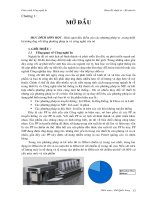Giáo trình control and simulation in LabVIEW
Bạn đang xem bản rút gọn của tài liệu. Xem và tải ngay bản đầy đủ của tài liệu tại đây (1.8 MB, 61 trang )
g
ControlandSimulation
inLabVIEW
Hans-PetterHalvorsen
ControlandSimulationinLabVIEW
Hans-PetterHalvorsen
Copyright©2017
E-Mail:
Web:g
g
Preface
ThisdocumentexplainsthebasicconceptsofusingLabVIEWforControlandSimulation
purposes.
FormoreinformationaboutLabVIEW,visitmyBlog:g.
Youneedthefollowingsoftware:
•
•
•
•
•
LabVIEW
LabVIEWControlDesignandSimulationModule
LabVIEWMathScriptRTModule
NI-DAQmx
NIMeasurement&AutomationExplorer
TableofContents
Preface......................................................................................................................................3
TableofContents.....................................................................................................................iv
1
IntroductiontoLabVIEW...................................................................................................1
1.1
Dataflowprogramming...............................................................................................1
1.2
Graphicalprogramming..............................................................................................1
1.3
Benefits.......................................................................................................................2
2
IntroductiontoControlandSimulation............................................................................3
3
IntroductiontoControlandSimulationinLabVIEW.........................................................4
3.1
3.1.1
Simulation............................................................................................................5
3.1.2
ControlDesign.....................................................................................................5
3.2
LabVIEWPIDandFuzzyLogicToolkit..........................................................................6
3.2.1
PIDControl..........................................................................................................6
3.2.2
FuzzyLogic...........................................................................................................6
3.3
4
LabVIEWControlDesignandSimulationModule.......................................................4
LabVIEWSystemIdentificationToolkit.......................................................................7
Simulation.........................................................................................................................8
4.1
SimulationinLabVIEW................................................................................................8
4.2
SimulationSubsystem...............................................................................................13
4.3
ContinuousLinearSystems.......................................................................................14
Exercises..............................................................................................................................19
5
PIDControl......................................................................................................................31
5.1
PIDControlinLabVIEW............................................................................................32
iv
v
5.2
6
SystemIdentificationinLabVIEW.............................................................................35
FuzzyLogic.......................................................................................................................36
8.1
9
ControlDesigninLabVIEW.......................................................................................34
SystemIdentification.......................................................................................................35
7.1
8
Auto-tuning...............................................................................................................33
ControlDesign.................................................................................................................34
6.1
7
TableofContents
FuzzyLogicinLabVIEW.............................................................................................36
LabVIEWMathScript.......................................................................................................38
9.1
Help...........................................................................................................................39
9.2
Examples...................................................................................................................39
9.3
Usefulcommands.....................................................................................................42
9.4
Plotting.....................................................................................................................42
10 Discretization...................................................................................................................43
10.1 Low-passFilter..........................................................................................................43
10.2 PIController..............................................................................................................46
10.2.1 PIControllerasaState-spacemodel.................................................................49
10.3 ProcessModel..........................................................................................................50
Tutorial: Control and Simulation in LabVIEW
1 IntroductiontoLabVIEW
LabVIEW(shortforLaboratoryVirtualInstrumentationEngineeringWorkbench)isa
platformanddevelopmentenvironmentforavisualprogramminglanguagefromNational
Instruments.Thegraphicallanguageisnamed"G".OriginallyreleasedfortheApple
Macintoshin1986,LabVIEWiscommonlyusedfordataacquisition,instrumentcontrol,and
industrialautomationonavarietyofplatformsincludingMicrosoftWindows,variousflavors
ofLinux,andMacOSX.VisitNationalInstrumentsatwww.ni.com.
Thecodefileshavetheextension“.vi”,whichisanabbreviationfor“VirtualInstrument”.
LabVIEWofferslotsofadditionalAdd-OnsandToolkits.
1.1 Dataflowprogramming
TheprogramminglanguageusedinLabVIEW,alsoreferredtoasG,isadataflow
programminglanguage.Executionisdeterminedbythestructureofagraphicalblock
diagram(theLV-sourcecode)onwhichtheprogrammerconnectsdifferentfunction-nodes
bydrawingwires.Thesewirespropagatevariablesandanynodecanexecuteassoonasall
itsinputdatabecomeavailable.Sincethismightbethecaseformultiplenodes
simultaneously,Gisinherentlycapableofparallelexecution.Multi-processingandmultithreadinghardwareisautomaticallyexploitedbythebuilt-inscheduler,whichmultiplexes
multipleOSthreadsoverthenodesreadyforexecution.
1.2 Graphicalprogramming
LabVIEWtiesthecreationofuserinterfaces(calledfrontpanels)intothedevelopmentcycle.
LabVIEWprograms/subroutinesarecalledvirtualinstruments(VIs).EachVIhasthree
components:ablockdiagram,afrontpanel,andaconnectorpanel.Thelastisusedto
representtheVIintheblockdiagramsofother,callingVIs.Controlsandindicatorsonthe
frontpanelallowanoperatortoinputdataintoorextractdatafromarunningvirtual
instrument.However,thefrontpanelcanalsoserveasaprogrammaticinterface.Thusa
virtualinstrumentcaneitherberunasaprogram,withthefrontpanelservingasauser
interface,or,whendroppedasanodeontotheblockdiagram,thefrontpaneldefinesthe
inputsandoutputsforthegivennodethroughtheconnectorpane.ThisimplieseachVIcan
beeasilytestedbeforebeingembeddedasasubroutineintoalargerprogram.
1
2
IntroductiontoLabVIEW
Thegraphicalapproachalsoallowsnon-programmerstobuildprogramssimplybydragging
anddroppingvirtualrepresentationsoflabequipmentwithwhichtheyarealreadyfamiliar.
TheLabVIEWprogrammingenvironment,withtheincludedexamplesandthe
documentation,makesitsimpletocreatesmallapplications.Thisisabenefitononeside,
butthereisalsoacertaindangerofunderestimatingtheexpertiseneededforgoodquality
"G"programming.Forcomplexalgorithmsorlarge-scalecode,itisimportantthatthe
programmerpossessanextensiveknowledgeofthespecialLabVIEWsyntaxandthe
topologyofitsmemorymanagement.ThemostadvancedLabVIEWdevelopmentsystems
offerthepossibilityofbuildingstand-aloneapplications.Furthermore,itispossibletocreate
distributedapplications,whichcommunicatebyaclient/serverscheme,andaretherefore
easiertoimplementduetotheinherentlyparallelnatureofG-code.
1.3 Benefits
OnebenefitofLabVIEWoverotherdevelopmentenvironmentsistheextensivesupportfor
accessinginstrumentationhardware.Driversandabstractionlayersformanydifferenttypes
ofinstrumentsandbusesareincludedorareavailableforinclusion.Thesepresent
themselvesasgraphicalnodes.Theabstractionlayersofferstandardsoftwareinterfacesto
communicatewithhardwaredevices.Theprovideddriverinterfacessaveprogram
developmenttime.ThesalespitchofNationalInstrumentsis,therefore,thatevenpeople
withlimitedcodingexperiencecanwriteprogramsanddeploytestsolutionsinareduced
timeframewhencomparedtomoreconventionalorcompetingsystems.Anewhardware
drivertopology(DAQmxBase),whichconsistsmainlyofG-codedcomponentswithonlya
fewregistercallsthroughNIMeasurementHardwareDDK(DriverDevelopmentKit)
functions,providesplatformindependenthardwareaccesstonumerousdataacquisition
andinstrumentationdevices.TheDAQmxBasedriverisavailableforLabVIEWonWindows,
MacOSXandLinuxplatforms.
Tutorial: Control and Simulation in LabVIEW
2 IntroductiontoControland
Simulation
Controldesignisaprocessthatinvolvesdevelopingmathematicalmodelsthatdescribea
physicalsystem,analyzingthemodelstolearnabouttheirdynamiccharacteristics,and
creatingacontrollertoachievecertaindynamiccharacteristics.
Simulationisaprocessthatinvolvesusingsoftwaretorecreateandanalyzethebehaviorof
dynamicsystems.Youusethesimulationprocesstolowerproductdevelopmentcostsby
acceleratingproductdevelopment.Youalsousethesimulationprocesstoprovideinsight
intothebehaviorofdynamicsystemsyoucannotreplicateconvenientlyinthelaboratory.
Belowweseeaclosed-loopfeedbackcontrolsystem:
3
3 ControlandSimulationin
LabVIEW
LabVIEWhasseveraladditionalmodulesandToolkitsforControlandSimulationpurposes,
e.g.,“LabVIEWControlDesignandSimulationModule”,“LabVIEWPIDandFuzzyLogic
Toolkit”,“LabVIEWSystemIdentificationToolkit”and“LabVIEWSimulationInterface
Toolkit”.LabVIEWMathScriptisalsousefulforControlDesignandSimulation.
•
•
•
•
LabVIEWControlDesignandSimulationModule
LabVIEWPIDandFuzzyLogicToolkit
LabVIEWSystemIdentificationToolkit
LabVIEWSimulationInterfaceToolkit
Thistutorialwillfocusonthemainaspectsinthesemodulesandtoolkits.
AllVIsrelatedtothesemodulesandtoolkitsareplacedintheControlDesignandSimulation
Toolkit:
3.1 LabVIEWControlDesignandSimulation
Module
WithLabVIEWControlDesignandSimulationModuleyoucanconstructplantandcontrol
modelsusingtransferfunction,state-space,orzero-pole-gain.Analyzesystemperformance
withtoolssuchasstepresponse,pole-zeromaps,andBodeplots.Simulatelinear,nonlinear,
anddiscretesystemswithawideoptionofsolvers.WiththeNILabVIEWControlDesignand
4
5
ControlandSimulationinLabVIEW
SimulationModule,youcananalyzeopen-loopmodelbehavior,designclosed-loop
controllers,simulateonlineandofflinesystems,andconductphysicalimplementations.
3.1.1
Simulation
TheSimulationpaletteinLabVIEW:
ThemainfeaturesintheSimulationpaletteare:
•
•
•
ControlandSimulationLoop-YoumustplaceallSimulationfunctionswithina
Control&SimulationLooporinasimulationsubsystem.
ContinuousLinearSystemsFunctions-UsetheContinuousLinearSystemsfunctions
torepresentcontinuouslinearsystemsofdifferentialequationsonthesimulation
diagram.
SignalArithmeticFunctions-UsetheSignalArithmeticfunctionstoperformbasic
arithmeticoperationsonsignalsinasimulationsystem.
3.1.2
ControlDesign
TheControlDesignpaletteinLabVIEW:
Tutorial: Control and Simulation in LabVIEW
6
ControlandSimulationinLabVIEW
3.2 LabVIEWPIDandFuzzyLogicToolkit
TheNILabVIEWPIDandFuzzyLogicToolkitaddcontrolalgorithmstoLabVIEW.By
combiningthePIDandfuzzylogiccontrolfunctionsinthistoolkitwiththemathandlogic
functionsinLabVIEWsoftware,youcanquicklydevelopprogramsforautomatedcontrol.
Youmayintegratethesecontroltoolswiththepowerofdataacquisition.
3.2.1
PIDControl
ThePIDpaletteinLabVIEW:
3.2.2
FuzzyLogic
TheFuzzyLogicpaletteinLabVIEW:
Tutorial: Control and Simulation in LabVIEW
7
ControlandSimulationinLabVIEW
3.3 LabVIEWSystemIdentificationToolkit
The“LabVIEWSystemIdentificationToolkit”combinesdataacquisitiontoolswithsystem
identificationalgorithmsforplantmodeling.YoucanusetheLabVIEWSystemIdentification
Toolkittofindempiricalmodelsfromrealplantstimulus-responseinformation.
TheSystemIdentificationpaletteinLabVIEW:
Tutorial: Control and Simulation in LabVIEW
4 Simulation
Simulationisaprocessthatinvolvesusingsoftwaretorecreateandanalyzethebehaviorof
dynamicsystems.Youusethesimulationprocesstolowerproductdevelopmentcostsby
acceleratingproductdevelopment.Youalsousethesimulationprocesstoprovideinsight
intothebehaviorofdynamicsystemsyoucannotreplicateconvenientlyinthelaboratory.
Forexample,simulatingajetenginesavestime,labor,andmoneycomparedtobuilding,
testing,andrebuildinganactualjetengine.YoucanusetheLabVIEWControlDesignand
SimulationModuletosimulateadynamicsystemoracomponentofadynamicsystem.For
example,youcansimulateonlytheplantwhileusinghardwareforthecontroller,actuators,
andsensors(Hardware-in-the-loopSimulation).
Adynamicsystemmodelisadifferentialordifferenceequationthatdescribesthebehavior
ofthedynamicsystem.
4.1 SimulationinLabVIEW
UsetheSimulationVIsandfunctionstocreatesimulationapplicationsinLabVIEW.Inthe
ControlDesign&SimulationpalettewehavetheSimulationSubpalette:
BelowweseetheSimulationSubpalette:
8
9
Simulation
Note!Allthe“Blocks”intheSimulationpalettearenotSubVIs,i.e.,wecannotdouble-click
onthemandopentheBlockDiagrambecausetheyhavenone.AlltheBlocksinthe
SimulationpalettemustbeusedinsidetheControlandSimulationLoop(explainedbelow).
ControlandSimulationLoop:
Inthe“Simulation”Subpalettewehavethe“ControlandSimulationLoop”whichisvery
usefulinsimulations:
YoumustplaceallSimulationfunctionswithinaControl&SimulationLooporinasimulation
subsystem.YoualsocanplacesimulationsubsystemswithinaControl&SimulationLoopor
anothersimulationsubsystem,oryoucanplacesimulationsubsystemsonablockdiagram
outsideaControl&SimulationLooporrunthesimulationsubsystemsasstand-aloneVIs.
Tutorial: Control and Simulation in LabVIEW
10
Simulation
TheControl&SimulationLoophasanInputNode(upperleftcorner)andanOutputNode
(upperrightcorner).UsetheInputNodetoconfiguresimulationparameters
programmatically.YoualsocanconfiguretheseparametersinteractivelyusingtheConfigure
SimulationParametersdialogbox.Accessthisdialogboxbydouble-clickingtheInputNode
orbyright-clickingtheborderandselectingConfigureSimulationParametersfromthe
shortcutmenu.
Configuration:
Whenyouplacetheseblocksonthediagramyoumaydouble-clickorright-clickandthen
select“Configuration…”
Example:ConfigurationDialogbox
Forthe“TransferFunction”(Simulation→ContinuousLinearSystems)blockwehave
thefollowingConfigurationwindow:
Tutorial: Control and Simulation in LabVIEW
11
Simulation
AllthedifferentblockshavetheirowndifferentConfigurationwindow.
IntheParametersourceyoumayselectbetween:
•
•
ConfigurationDialogBox
Terminal
Ifyouselect“ConfigurationDialogBox”youentertheconfigurationintheConfiguration
windowlikeweseeabove,whileifyouselect“Terminal”thatspecificconfigurationisset
fromtheBlockDiagramlikethis:
IconStyle:
Whenyouplacetheblockontheblockdiagramyoumayselecthowthatshouldappear.
Right-clickontheblock/iconandselect“IconStyle”:
Tutorial: Control and Simulation in LabVIEW
12
Simulation
Example:IconStyle
Forthe“TransferFunction”(Simulation→ContinuousLinearSystems)blockwehave
thefollowingdifferenticonstyles:
Static:
Dynamic:
TextOnly:
Express:
WeseefortheDynamicandExpressstylesthattheappearancechangesaccordingto
configurationparametersweset.
Tutorial: Control and Simulation in LabVIEW
13
Simulation
Ipersonallypreferthe“static”iconstylebecauseitdoesnotrequirelotsofspaceonthe
diagram.
4.2 SimulationSubsystem
YoumaycreateaSimulationSubsystem(File→New…):
TheSimulationSubsystemisveryusefulwhendealingwithlargersimulationsystemsin
ordertocreateamorestructuredcode.Irecommendthatyou(always)usethisfeature.
TheSimulationSubsystemisalmostequaltoanormalLabVIEWBlockDiagrambutnoticethe
backgroundcolorisslightlydarker.
Note!InordertoopentheSimulationSubsystem,right-clickandselect“OpenSubsystem”.
TheSimulationSubsystemmayalsoberepresentedbydifferenticons.Ifyouselect
“dynamic”iconstyle,youwillseea“miniature”versionofthesubsystemlikethis:
Tutorial: Control and Simulation in LabVIEW
14
Simulation
Youmaydraginthecornerinordertoincreaseordecreasethedynamicicon.
Ifyouselect“static”iconstyleyouseetheiconyoucreatedwiththeIconEditor.
Likethis:
4.3 ContinuousLinearSystems
Inthe“ContinuousLinearSystems”Subpalettewewanttocreateasimulationmodel:
ThemostusedblocksprobablyareIntegrator,TransportDelay,State-SpaceandTransfer
Function.
Tutorial: Control and Simulation in LabVIEW
15
Simulation
Whenyouplacetheseblocksonthediagramyoumaydouble-clickorright-clickandthen
select“Configuration…”
Integrator-Integratesacontinuousinputsignalusingtheordinarydifferential
equation(ODE)solveryouspecifyforthesimulation.
TheConfigurationwindowfortheIntegratorblocklookslikethis:
TransportDelay-Delaystheinputsignalbytheamountoftimeyouspecify.
TheConfigurationwindowfortheTransportDelayblocklookslikethis:
TransferFunction-Implementsasystemmodelintransferfunctionform.Youdefine
thesystemmodelbyspecifyingtheNumeratorandDenominatorofthetransferfunction
equation.
Tutorial: Control and Simulation in LabVIEW
16
Simulation
TheConfigurationwindowfortheTransferFunctionblocklookslikethis:
State-Space-Implementsasystemmodelinstate-spaceform.Youdefinethesystem
modelbyspecifyingtheinput,output,state,anddirecttransmissionmatrices.
TheConfigurationwindowfortheState-Spaceblocklookslikethis:
SignalArithmetic:
The“SignalArithmetic”Subpaletteisalsousefulwhencreatingasimulationmodel:
Tutorial: Control and Simulation in LabVIEW
17
Simulation
Example:SimulationModel
BelowweseeanexampleofasimulationmodelcreatedinLabVIEW.
Example:Simulation
BelowweseeanexampleofasimulationmodelusingtheControlandSimulationLoop.
Noticethefollowing:
Tutorial: Control and Simulation in LabVIEW
18
Simulation
Clickontheborderofthesimulationloopandselect“ConfigureSimulationParameters…”
Thefollowingwindowappears(ConfigureSimulationParameters):
InthiswindowyousetsomeParametersregardingthesimulation,someimportantare:
•
•
FinalTime(s)–sethowlongthesimulationshouldlast.Foraninfinitetimeset“Inf”.
EnableSynchronizedTiming-Specifiesthatyouwanttosynchronizethetimingof
theControl&SimulationLooptoatimingsource.Toenablesynchronization,placea
Tutorial: Control and Simulation in LabVIEW
19
Simulation
checkmarkinthischeckboxandthenchooseatimingsourcefromtheSourcetype
listbox.
ClicktheHelpbuttonformoredetails.
YoumayalsosetsomeoftheseParametersintheBlockDiagram:
YoumayusethemousetoincreasethenumbersofParametersandright-clickandselect
“SelectInput”.
Exercises
Exercise:Simulationofaspring-massdampersystem
Inthisexerciseyouwillconstructasimulationdiagramthatrepresentsthebehaviorofa
dynamicsystem.Youwillsimulateaspring-massdampersystem.
𝐹(𝑡) − 𝑐𝑥(𝑡) − 𝑘𝑥(𝑡) = 𝑚𝑥(𝑡)
wheretisthesimulationtime,F(t)isanexternalforceappliedtothesystem,cisthe
dampingconstantofthespring,kisthestiffnessofthespring,misamass,andx(t)isthe
positionofthemass. 𝑥 isthefirstderivativeoftheposition,whichequalsthevelocityof
themass. 𝑥 isthesecondderivativeoftheposition,whichequalstheaccelerationofthe
mass.
Thefollowingfigureshowsthisdynamicsystem.
Tutorial: Control and Simulation in LabVIEW
20
Simulation
Thegoalistoviewthepositionx(t)ofthemassmwithrespecttotimet.Youcancalculate
thepositionbyintegratingthevelocityofthemass.Youcancalculatethevelocityby
integratingtheaccelerationofthemass.Ifyouknowtheforceandmass,youcancalculate
thisaccelerationbyusingNewton'sSecondLawofMotion,givenbythefollowingequation:
Force=Mass×Acceleration
Therefore,
Acceleration=Force/Mass
Substitutingtermsfromthedifferentialequationaboveyieldsthefollowingequation:
𝑥=
1
(𝐹 − 𝑐𝑥 − 𝑘𝑥)
𝑚
Youwillconstructasimulationdiagramthatiteratesthefollowingstepsoveraperiodof
time.
CreatingtheSimulationDiagram
YoucreateasimulationdiagrambyplacingaControl&SimulationLoopontheLabVIEW
blockdiagram.
1. LaunchLabVIEWandselectFile»NewVItocreateanew,blankVI.
2. SelectWindow»ShowBlockDiagramtoviewtheblockdiagram.Youalsocanpress
the<Ctrl-E>keystoviewtheblockdiagram.
3. IfyouarenotalreadyviewingtheFunctionspalette,selectView»FunctionsPaletteto
displaythispalette.
4. SelectControlDesign&Simulation»SimulationtoviewtheSimulationpalette.
5. ClicktheControl&SimulationLoopicon.
6. Movethecursorovertheblockdiagram.Clicktoplacethetopleftcorneroftheloop,
dragthecursordiagonallytoestablishthesizeoftheloop,andclickagaintoplace
theloopontheblockdiagram.
ThesimulationdiagramistheareaenclosedbytheControl&SimulationLoop.Noticethe
simulationdiagramhasapaleyellowbackgroundtodistinguishitfromtherestoftheblock
diagram.YoucanresizetheControl&SimulationLoopbydraggingitsborders.
ConfiguringSimulationParameters
TheControl&SimulationLoopcontainstheparametersthatdefinehowthesimulation
executes.Completethefollowingstepstoviewandconfigurethesesimulationparameters.
1. Double-clicktheInputNode,attachedtotheleftsideoftheControl&Simulation
Loop,todisplaytheConfigureSimulationParametersdialogbox.YoualsocanrightTutorial: Control and Simulation in LabVIEW









